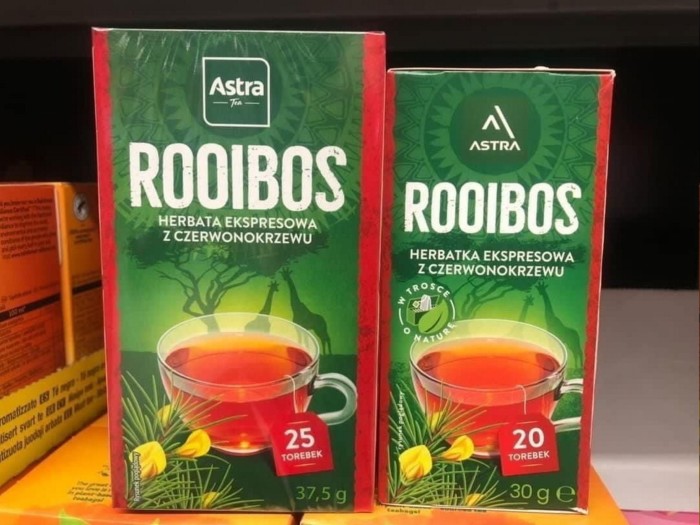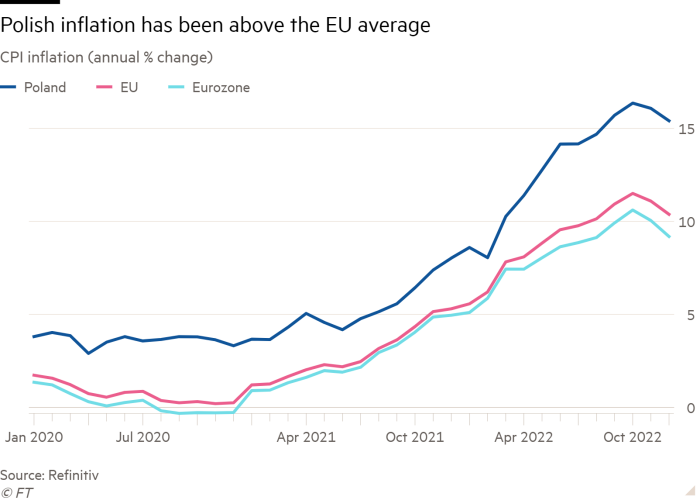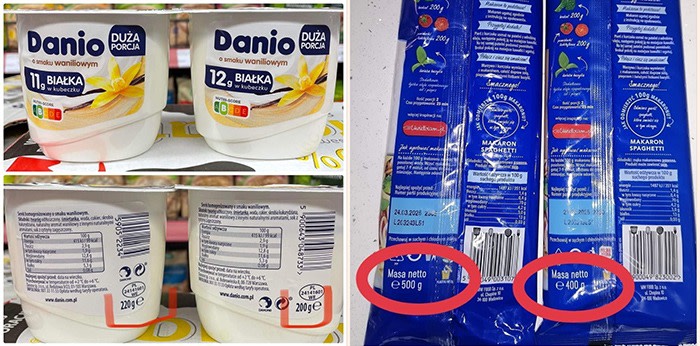[ad_1]
A trip to the supermarket in Poland now requires not only a full wallet but also a magnifying glass to check the fine print on the packaging.
Parents tasked with wiping their children’s runny noses this winter have been caught out by packets containing not 10, but eight tissues. The health-conscious have found their half-kilo tubs of kefir cut to 420g. The famous “Bird’s milk” chocolate box sold by local confectioner Wedel now contains just 340g of the sweet stuff, down from 360g in December.
With inflation at about 17 per cent — almost double the eurozone average — retailers and food producers in Poland are resorting to a practice as old as price pressures to hide the rise in costs from their customers.
That practice is “shrinkflation”, a phenomenon that involves skimping on the amount — or quality — of produce sold to consumers, rather than raising the cost of the item itself. It is a technique that has been used by everyone from Roman emperors, who debased silver and gold coins with copper and other cheaper metals to finance their empire-building, to bakers in the Middle Ages, who tried to prevent bread riots by selling smaller loaves.
In Poland, following a surge in producers’ energy costs triggered by Russia’s full-scale invasion of Ukraine, consumer goods companies have devised sneaky albeit legal ways to hide the fact they are forcing their consumers to pay the same for less. They are reshaping bottles and tubs, thinning down cleaning sponges and reducing the size of their bags of crisps.

Polish economist Rafał Mundry, who has been compiling a shrinkflation database for the past four years, described it as “the shadow side of inflation that many people unfortunately don’t notice or don’t even ever think about”. With inflation at a 25-year high, Mundry said packaging was being changed “on a scale I’ve never seen before”.
As in many other countries, Poland’s statistics office calculates inflation by focusing on the cost of items based on their actual weight rather than the format in which they are sold. If a confectioner cuts the amount of chocolate in each of their bars, this will show up in the statistics. Yet those cuts may not be spotted by consumers doing their weekly shop.
Katarzyna Bosacka, a food and consumer affairs pundit, is urging customers to spend more time reading not only the price tags but the labels as well. “I can only say one thing: everything is bigger in Texas, everything is getting smaller in stores in Poland,” she said.
“It’s a question of habit,” said Mundry. “When we buy our cheese, we know perfectly well that it can be packaged in all sorts of sizes, so we actually look at whether it weighs half a kilo, 250g, 150g or 100g.”

Consumer goods producers argue that they have little choice but to rely on customers’ reluctance not to check familiar items as their production costs have soared by 30 to 40 per cent on the back of higher inflation.
Paweł Bajorek, regional director of UK consumer goods company Reckitt Benckiser, said: “You cannot just increase prices that much in one shot.”
Among its flagship products on sale in Poland, Reckitt is now selling its Finish dishwasher detergent in batches of 46 tablets, down from 50. Bajorek also noted that repackaging had logistical challenges and limitations, as companies needed to change the certified bar code on each new packaging. “The bad message for consumers is that there will probably be more price increases,” Bajorek said, adding that these would be introduced gradually over the coming months.

In some cases, soaring production costs are also getting passed on to consumers by using cheaper ingredients — something that is even harder for both consumers and statisticians to track.
Mundry has found more palm oil in his butter, less fluoride in his mouthwash and more glucose syrup being substituted for sugar in his confectionery. In almost every case, he said, the change had been so subtle that he had to compare new labels with older ones to identify it.
He mostly shops at Biedronka, one of the biggest supermarket chains in Poland, but he has found similar issues in other stores. Katarzyna Grabarna, brand development manager at Biedronka, said that altering the weight or content of own-brand products was not “our focus when it comes to looking for savings”.
Instead, she said, Biedronka was prioritising reducing the plastic in its packaging and improving bulk packaging and deliveries. Biedronka’s packaging alterations meant it reduced its use of plastic by 600 tonnes last year.
Still, Mundry worries about the quality of what people now buy in inflation-hit Poland.
“It’s very surprising to me how the ingredients in some products have recently been changed, unfortunately never for the better and sometimes for much worse in terms of our health,” he said.
[ad_2]
Source link
